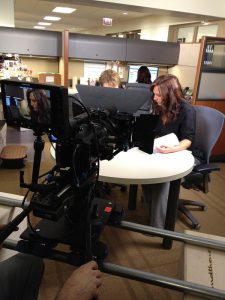Making quality videos is about the vision and talent of the crew, but also the power and capabilities of their tools and equipment. For years we used an XDCAM HD PMW350 camera, a good camera, but it was time for an upgrade. We did our research, our Director of Photography, Ed Boe did even more research, and finally we invested in a Sony PMW-F3 for a variety of reasons:
Super-sized sensor
The sensor inside the F3 is a Super 35-sized CMOS sensor. In english: it’s larger and contains more and larger pixels and photo receptors.
In plainer English: the F3 enables us to collect more/better light and resolve detail. “This means a brighter, cleaner image with less need to boost the gain,” says Boe. So, instead of needing to boost the gain and brighten the image artificially, with the F3 we’re able to get that crisp, noise-free image naturally.
Narrower depth of field
The F3 can achieve a much more narrow depth of field, that’s less background and foreground nonsense in focus beyond the point of critical focus, the point you choose to be in focus, reducing clutter and visual distractions and allowing you to better separate the subject of the shot.
“The out of focus area or Bokeh is very pleasing to the eye,” says Boe, “and it more accurately simulates the look and feel of 35mm film, which is the industry standard for feature filmmaking…in other words, it looks more cinematic.”
Easily change out lenses
With the F3 we can swap out the lenses to achieve different effects. This is vastly preferred to trying to use a standard zoom lens for everything. We have a set of 5 fast Carl Zeiss prime lenses covering a wide range from 18mm-85mm. A lens ‘speed’ refers to the amount of light that can be let through the lens, into the camera’s sensor. “The faster the lens, the more ability you have to limit depth of field,” says Boe, “the Carl Zeiss lenses are prime, they can act faster and sharper than a standard zoom lens in the same range.”

While Boe could claim credit for our beautiful shots, he says that the precision and quality of these Carl Zeiss lenses definitely contribute to the gorgeous images we get at SolidLine.
In the end, the F3 was an excellent choice of camera. Along with it’s enhanced resolution, the F3 allows for better color processing, finer controls of the settings and, perhaps most importantly, the aforementioned narrower possible depth of field.
Though, we can’t let Boe walk away without taking any credit. At SolidLine we we compose each shot to be individual, unique and tailored to the audience of the video. “Dynamic shots go a long way. They keep the attention of their intended audience and they have the added benefit of facilitating the flow of information as well,” says Boe. Add into that a solid knowledge of both photographic and cinematographic composition and execution [Enter: Ed Boe and the SolidLine crew] and you have all the makings of a really great video.
Tell Us About Your Project
Regardless of the type of video your organization needs from our team, there’s a
perfect mix of live video and motion graphics that will meet your needs